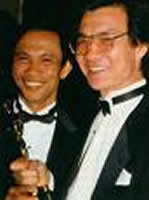
Dith Pran and Haing Gnor
April 4 is Martin Luther King Day. Many writers will be penning another encomium to this great leader and visionary, with a lot of allusions to the prospect of an African-American man residing in the White House. So I’ll take this opportunity to say a few words about another true hero of mine, another “man of the people” who really acted for all people.
By a stroke of good luck the French Embassy was just down the street from my hotel in Phnom Penh when I visited there a few years ago. One of my reasons for my wanting to go to Cambodia was to see the place that was a prime location in the movie The Killing Fields. It still is the French Embassy today. But back then, in April 1975, it was the last, and tenuous, refuge for foreign journalists in Cambodia’s capital that had been taken by the Khmer Rouge. The tense, frantic, scenes from the movie ran in my head as I passed by it, serene and showing no evidence of the time when over 1,400 Cambodians and foreigners took refuge in the compound.
This was brought to mind yesterday by the announcement of the death of Dith Pran. Pran is a real hero of mine (at a time when the word “hero” is used on the likes of John McCain). Pran, a native Cambodian and photographer, was a “fixer” for Sydney Schanberg of the New York Times during the Vietnam War and the political breakdown of Cambodia stimulated by the invasion and bombing tactics of Nixon and Kissinger. A monstrous madness took over Cambodia, with country boy Khmer Rouge who would unload an AK-47 in anybody for a smile. In the end they killed almost half the population, many of them babies, whose heads they enjoyed smashing against trees.
Few reporters, if any, could operate without brave guys like Pran, who put themselves in an extreme danger zone, even more dangerous than that of the Westerners he worked for because local political forces could regard them as collaborators or traitors. So when the bad times came Pran’s family was able to get out safely, but Pran himself was trapped. The Killings Field’s recounts how he saved several reporters, among them Schanberg and Jon Swain and photographer Al Rockoff from almost certain execution by the Khmer Rouge, even though he might have been killed for taking their part. He could have run for his life, but he stayed. In the compound they tried to fashion a foreign passport for Pran, but lacked sufficient photographic supplies to make a credible photograph. The reporters got put, but their “fixer” was in a real fix. He had money for bribes, but he had to strip himself of his identity and try to survive the brutal regime that controlled his country.
When Pran got up near his hometown of Siem Reap, near the magnificent ruins of Angkor Wat, he found that his father had starved to death and four of his five siblings were probably among the thousands of skeletons of the murdered he came upon in fields nearby. But he was blessed with the natural instincts of a survivor—adaptability and audacity. After he was caught for stealing food from a rice field and beaten by the Khmer Rouge he managed to ingratiate himself sufficiently with a local commune chieftain to get enough protection and food to hold on. He managed ton sneak a listen to the chief’s radio, learning from Voice of America that the Vietnamese were mobilizing against the Khmer Rouge. When the Khmer Rouge learned of his previous connection with the New York Times he headed for the Thai border, nearly not making it when a land mine blew up two men walking in front of him and also wounding him in the leg.1 After waiting seventeen days for the right opportunity he crossed the border and still had to convince the Thai authorities of who he was before being allowed into a refuges camp. Shortly afterwards he was re-united with Schanberg.
Dith Pran could easily have been a moldering skull in one of Cambodia’s killing fields, but he survived to serve as a photographer for the New York Times until his death from cancer last week. He managed to be survived in turn by his four children, six grandchildren and two step-grandchildren. His story survives continues to inspire by the great film by Roland Joffe, The Killing Fields (1984). In that film Pran is played by another Kiliing Fields survivor who had been imprisoned and tortured, Dr. Haing S. Ngor. Ngor won an Oscar for his performance but was mysteriously murdered near his home in Los Angeles, perhaps because of his activism in human rights organizations in Cambodia. Another true hero.2
___________________________________
© 2008, James A. Clapp (UrbisMedia Ltd. Pub. 4.8.2008)
1. Even today one can see more one-legged people in Cambodia than probably anywhere else on earth. The place is still riddled with land mines. They warn tourists to stay on the well-worn trails, even near the famous archeological sites. In Cambodia you don’t go far off the trail to pee; you might come hopping back on one leg.
2. See also Archives No. 3. 10 on this subject.
